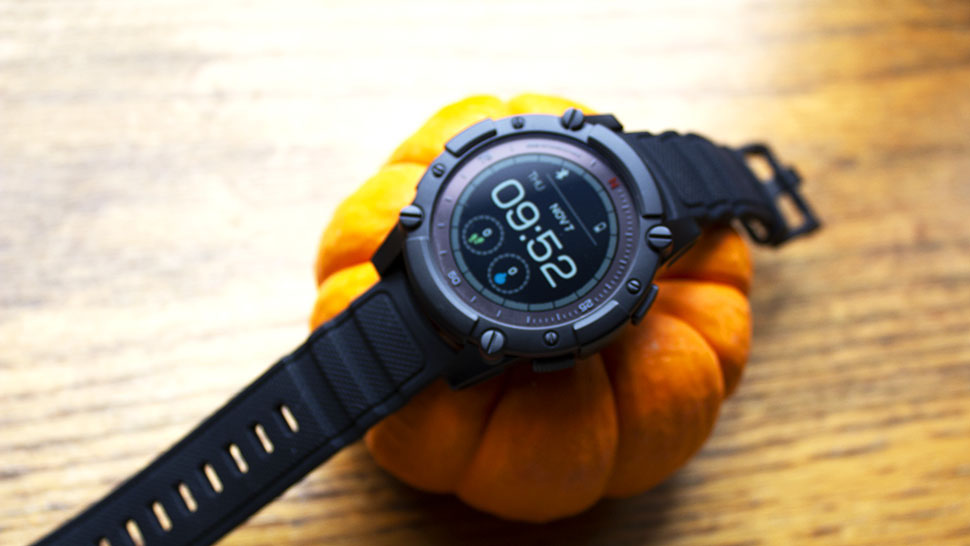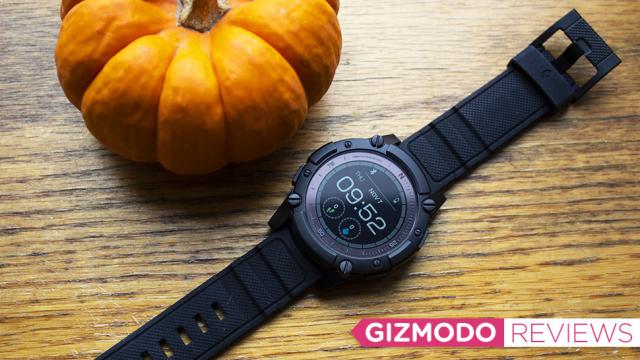There are two camps when it comes to smartwatch battery life: Those who don’t care at all (Apple Watch stans) and those who care a whole friggin’ lot. For the latter, Matrix Industries’ PowerWatch Series 2 seems like a dream. Powered by both body heat and solar energy, it’s the fitness smartwatch that never runs out of battery so long as you keep wearing it.
Editor’s Note: Australian pricing and availability is yet to be confirmed.
The idea of never charging your smartwatch is compelling—but it comes at a cost. The PowerWatch Series 2, despite its name, is Matrix’s third attempt at the device. The original PowerWatch was promising but was bare-bones as a device could get. We found the PowerWatch X to be a mild step up, but it was still lacklustre when it came to smart features.
Notifications were a blip. You could see if you got one, but there was no way to scroll through a list or glean information about the sort of notification you were getting. The screen was dim, fitness tracking was basic, and at the end of the day, it was more a showcase for Matrix’s novel thermoelectric technology than a smartwatch you’d actually want to buy.

PowerWatch Series 2
What is it?
Matrix Industries' third attempt at a body-powered smartwatch
Price
$US500 ($727)
Like
You never have to charge it.
No Like
It thinks I'm dead. Buggy software.
When the Series 2 reviewed here was announced at CES 2019, it seemed promising as it added a solar cell in the bezel. The extra juice from the solar cell means built-in GPS, a full-colour LCD display, compass, and heart rate monitoring. Those are all promising additions, but it also bumps the price up from $US280 ($407) to $US500 ($727). That’s no small change. You might get away with an experimental smartwatch for $US280 ($407), but paying half a grand is a much steeper ask for novelty.
For $US500 ($727) (or less, even), you could easily buy a slick, full-featured smartwatch. That’s the cost of a cellular Apple Watch Series 5! Even the Galaxy Watch Active2 is less expensive at $US280 ($407)-$US300 ($436) depending on the size. Plus, with the upgrade to a full-colour LCD screen, the Series 2 isn’t what I’d call a full-featured smartwatch. You can’t take calls on it, there’s no option for contactless payments, and notifications are still limited.
To be clear, notifications are better than on the PowerWatch X—just not by much. The main difference is now you can see a list of notifications received, and expand the message to read it in its entirety. The screen is also still incredibly dim. You need bright ambient lighting to read the thing, so it’s not much of an improvement other than now there’s colour. (The screen is nowhere near as bright as it appears in promotional materials.) In dark areas, you can turn on a backlight by holding one of the watch’s four navigational buttons, but it doesn’t help that much.
So, ok. It’s not a fancy, top-of-the-line smartwatch. Whatever. Premium fitness smartwatches, like the Garmin Fenix series, cost a small fortune. Yet on paper, the Series 2 should theoretically compete—especially as its added heart rate monitoring and built-in GPS.
An outdoor fitness enthusiast who spends hours upon hours trekking up mountains and plumbing the depths of the ocean is more likely to be intrigued by a GPS, heart-rate monitoring watch with infinite battery life. For all that, $US500 ($727) seems like a reasonable price—the latest, beefiest Garmin Fenix 6X Pro Solar, for example, is a whopping $US1,000 ($1,454). The smaller Fenix 6S is still more expensive at $US600 ($872).
So does it live up to that promise? Nope.
My gripe with the Series 2 is the software. In my time with the watch, I never really got it to work the way I believe Matrix intended it to. When I tried to take a GPS run, it couldn’t seem to find any signal. I waited maybe five minutes before my impatience got the better of me. I opted to run without the GPS, but got zero credit from the watch. No pace calculations, no steps, no calories burned. That was weird, and I figured it might be a bug because I’d tried to run with the thing almost right after unboxing. So factory reset, downloaded a new firmware update, bada bing, bada boom. Still nothing.
After a whole day of wearing the device it logged me as having burned a whopping 5 calories and zero steps. This was horseshit. For that day, it didn’t seem to log my heart rate aside from two spot checks, where I was at 92 beats per minute and 88 bpm respectively. Funnily enough, the watch had no real problem tracking how much energy—and thereby battery power—I was generating. Even though it failed to reliably track every other metric, that was never an issue. I wore the watch to bed and in the morning, I could see how much power I’d generated overnight (not much, 15 uwH, half of which came from body heat, the other half from lighting.) The problem was, it said I’d slept zero hours.
Another factory reset, still nothing. I unpaired and then re-paired the watch, and voila, I thought it was fixed. I got about 173 steps before the watch decided that nah, it wasn’t gonna bother tracking anymore. Still, I’d gotten it to work somewhat so I tried my third factory reset and pairing dance. Huzzah, it tracked my steps and calories again! For 166 steps and 10 calories. Then it quit on me again. By then, I felt pretty defeated.
Throughout all this, the watch never failed to deliver notifications or track how much power it was sucking from my body—and that’s what gets me. Some parts of the software clearly work just fine, and even if it’s not properly measuring my stats, this thing knows I’m not dead. I wore it to a boxing class and while it gave me no heart rate readings, calories burned, or steps, it definitely noted an uptick in the thermoelectric energy I was generating.
And maybe that’s the problem. Matrix told me that the watch currently “requires about 6,000uwH a day.” But on a day where I walked outside in direct sunlight for about 30 minutes, went to a 60-minute boxing class, and racked up 11,695 steps according to my Apple Watch, I only generated about 108 uwH. Matrix says an over-the-air update in December will reduce the daily requirement to about 4,000uwH, but that’s still an exponentially higher amount of energy than what I generated on a fairly active day.
But for argument’s sake, let’s say it wasn’t a power issue and my watch is a rogue offender. The moments where it did work as intended were still lacking. A Fitbit, Garmin, Wear OS device, and Apple Watch are all snappy at updating you on your step count. With the Series 2 there’s noticeable lag that made me question if it was working, or in need of yet another reset.
From a GPS perspective, the watch’s unique zero-battery feature has drawbacks too. The watch’s user manual notes that GPS should only be used for 30 minutes a day—or it’ll deplete the battery. That said, if you don’t use all 30 of your GPS minutes one day, it’ll get rolled over to the next day for a maximum of 10 GPS hours. This does not make sense if you regularly run longer distances.
For instance, I’m currently training for a 10K, which involves running four times a week—one of which is a long run. If I’m running every other day, and my short runs already exceed 30 minutes, it seems I’d never really have enough banked for my long run. That problem intensifies for people training for longer distances, like a half marathon or marathon. Another quibble—there’s currently no way to check on the watch or in the companion app how much GPS time you have banked. You’d just have to keep track and do the maths in your head.
The watch is also currently limited in the activities it can track. Right now, it’s only capable of logging indoor and outdoor running and walking, plus outdoor cycling. At this point, most fitness watches will let you track many activities beyond that. Matrix told me that it plans on future over-the-air updates in 2020 that will add more activities and UX updates to fix this.
All these issues make me feel like the Series 2 was rushed. The hardware itself seems fine. True to its word, I’ve never needed to charge the thing and I get notifications just fine. But any hybrid smartwatch will get you simple notifications and long-lasting battery for much cheaper. Again, in my conversation with Matrix about the issues I’d experienced, I was told the Series 2 will be the company’s flagship for a while. “We’re very happy with the hardware, and are focused on providing meaningful feature updates and bug fixes in the near and long terms,” a spokesperson told me over email.
Maybe those bug fixes and updates will fix a lot of the issues I had. But I also feel like it’s not insane to want a device to work as soon as you pull it out of the box. I would’ve been happy to wait a few months more if it meant I didn’t have to do the whole factory-reset-and-unpair routine over and over again. Matrix is definitely onto something with its thermoelectric tech. I would love wireless, body-powered earbuds that don’t die mid-run. But for now, the Series 2 feels like yet another unfulfilled promise.
README:
-
First things first, you never have to charge this thing. Yay!
-
Adds a solar cell for extra juice. Also enables GPS, full-colour LCD display, compass, and heart rate monitoring.
-
Too bad the software was buggy as hell. In testing, required multiple factory resets.
-
Even with resets, never really got the thing to work as Matrix Industries probably intended it to work.
-
$US500 ($727) is a bit much for a device that doesn’t reliably work.
